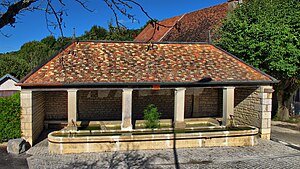Tallenay
| Tallenay | ||
|---|---|---|
|
|
||
| region | Bourgogne-Franche-Comté | |
| Department | Doubs | |
| Arrondissement | Besançon | |
| Canton | Besançon-3 | |
| Community association | Grand Besançon | |
| Coordinates | 47 ° 18 ' N , 6 ° 1' E | |
| height | 358-543 m | |
| surface | 2.34 km 2 | |
| Residents | 414 (January 1, 2017) | |
| Population density | 177 inhabitants / km 2 | |
| Post Code | 25870 | |
| INSEE code | 25557 | |
 Lavoir in Tallenay |
||
Tallenay is a French municipality with 414 inhabitants (as of January 1 2017) in Doubs in the region Bourgogne Franche-Comté .
geography
Tallenay is located at 410 m , about eight kilometers north of the city of Besançon (as the crow flies). The village extends in a valley between two western foothills of the Grande Côte (Forêt de Chailluz), in the extreme northwest of the Doubs department.
The area of the 2.34 km² municipal area comprises a section of the undulating landscape between the rivers of Doubs in the south and Ognon in the north. The main part of the area is taken up by the approximately 700 m wide Tallenay basin, which opens to the southwest, but has no surface running water. This basin is flanked in the south by a ridge of the Forêt de Chailluz, in the north by the height of Châtillon-le-Duc. To the east the terrain rises to the ridge of the Grande Côte (with the Fort de la Dame Blanche ). Here, at 543 m, the highest point in Tallenay is reached.
Neighboring municipalities of Tallenay are Bonnay in the northeast, Besançon in the south and Châtillon-le-Duc in the west.
history
The municipality of Tallenay was settled very early, which was proven by the discovery of Gallo-Roman tombs (5th century) when the road to Fort de la Dame Blanche was built in 1875. Tallenay was first mentioned in a document in 1290 under its current name. Talennay (1307), Thalenay (1328), Villa Tallaniaco (1409) and Thallenay (1580) have survived from the following period . The place name goes back to the Gallo-Roman personal name Tallenius .
However, the village is much older than it was first mentioned in a document. A first church, the remains of which are still visible on the ridge of the Forêt de Chailluz, was founded around 760. In the Middle Ages, Tallenay belonged partly to the chapter in Besançon and partly to the lordship of Châtillon-le-Duc. The village was in 1479 when the troops marched in under King Louis XI. and destroyed in 1639 by the troops of Duke Bernhard von Sachsen-Weimar during the Thirty Years' War . Together with Franche-Comté , Tallenay finally came to France with the Peace of Nijmegen in 1678.
Attractions
The village church of Tallenay originally dates back to the 11th century, but was largely rebuilt at the beginning of the 19th century. It has the oldest bell in the department, dating from 1420.
population
| Population development | |
|---|---|
| year | Residents |
| 1962 | 34 |
| 1968 | 35 |
| 1975 | 110 |
| 1982 | 328 |
| 1990 | 384 |
| 1999 | 394 |
| 2004 | 393 |
| 2016 | 409 |
With 414 inhabitants (as of January 1, 2017) Tallenay is one of the small communities in the Doubs department. After the population in the first half of the 20th century had always been in the range between 30 and 50 people, a marked increase in population was recorded, especially during the 1970s. Since then the number of inhabitants has increased more than tenfold.
Economy and Infrastructure
Until well into the 20th century, Tallenay was mainly a village characterized by agriculture (arable farming, fruit growing and cattle breeding) and forestry. In addition, there are now some local small businesses. In the meantime, the village has also turned into a residential community. Many workers are therefore commuters who go to work in the Besançon agglomeration.
The village is located away from the larger thoroughfares, but is still well developed in terms of traffic. The main access is via Châtillon-le-Duc. The closest connection to the A36 motorway is around five kilometers away.
